Nature post again!
I don't have much to talk about besides nature posts, but at least on the weekend I can take a walk and go look for some cool things. I do have to be careful, though... I've been told that my hip flexor injury will not get better if I keep damaging it. Psh.
Anyway...
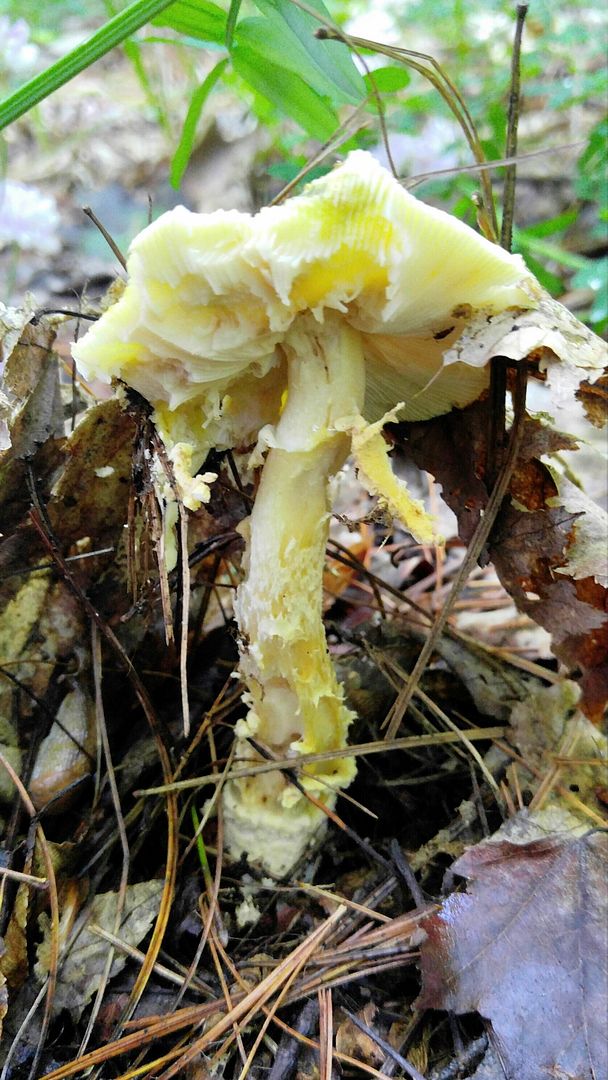
This was not a promising start to my mushroom search.

This is bee balm, one of the prettiest and most brightly colored wildflowers. They are native to North America and are members of the mint family.
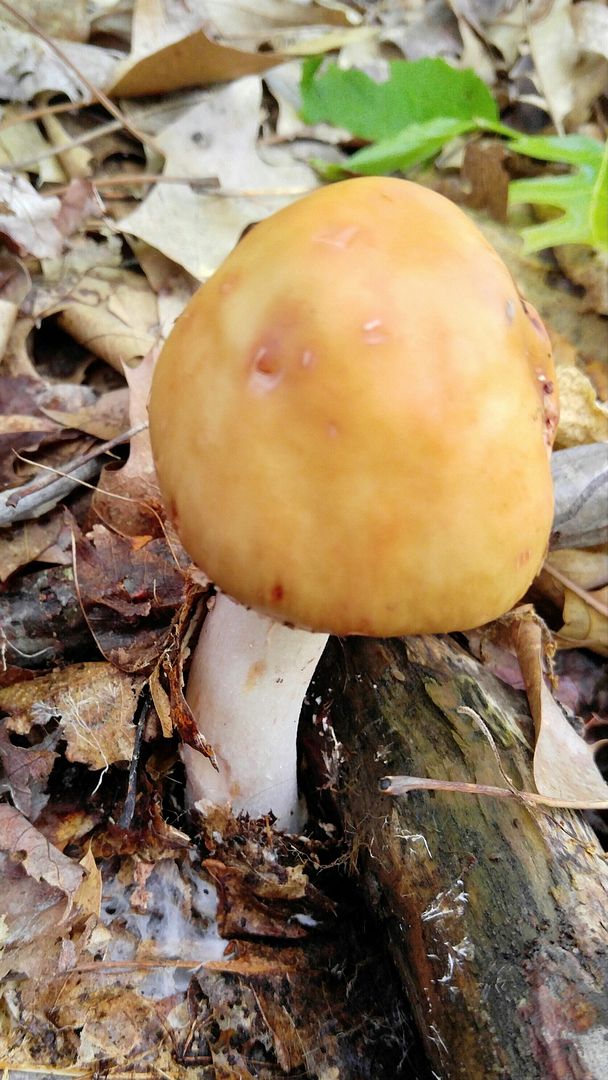
Found this pretty little one... and I cleared some of the leaves away at the base. If you look, the white fuzzy stuff is the actual fungus. The mushroom is just a fruiting body, temporary and meant only for spore dispersal. It's as if all we ever saw of a tree was when the fruit popped out of the ground, and we never thought about the entire tree living underneath. This one mushroom has a large mass of mycelium under it, digesting many layers of dead leaves and turning them into soil.
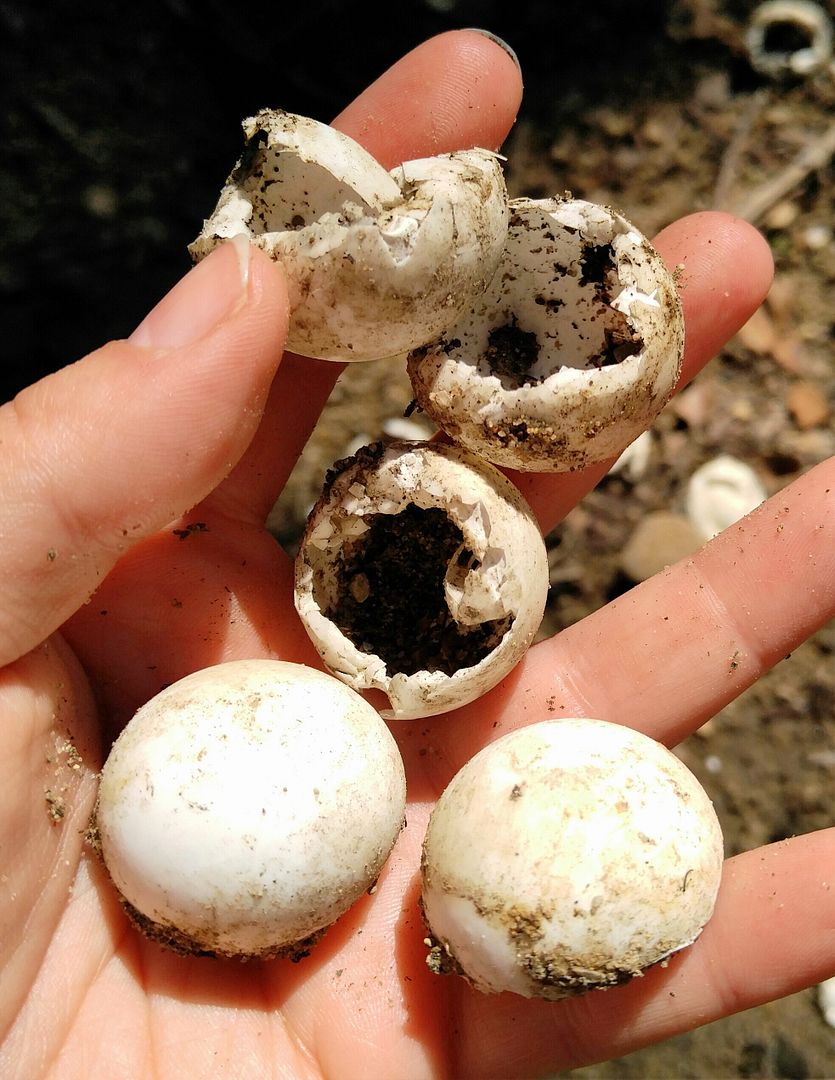
Turtle shells! They've been there since last time I showed them to you, but I didn't give you an idea of size or a close-up view then. You can tell just to look at them that these are not bird eggs... reptile eggs will crush if you squeeze them, but the texture is much more leathery and flexible than a bird egg. It's thought that the first feathers probably did not evolve for flight... after all, several sorts of things were already flying quite well without any such thing... but as insulation for nesting dinosaurs who sat on their nests like big, toothy chickens.
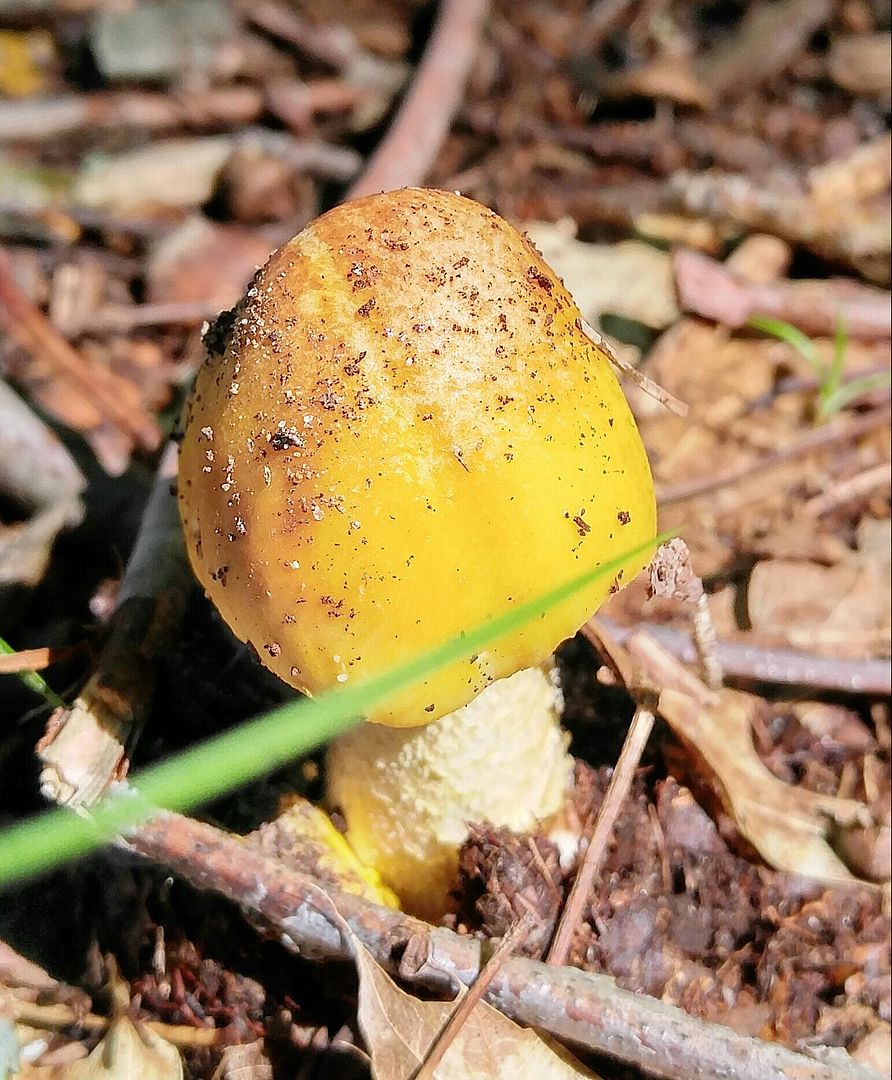
You can tell a mushroom is a baby if nothing has eaten holes in it yet.
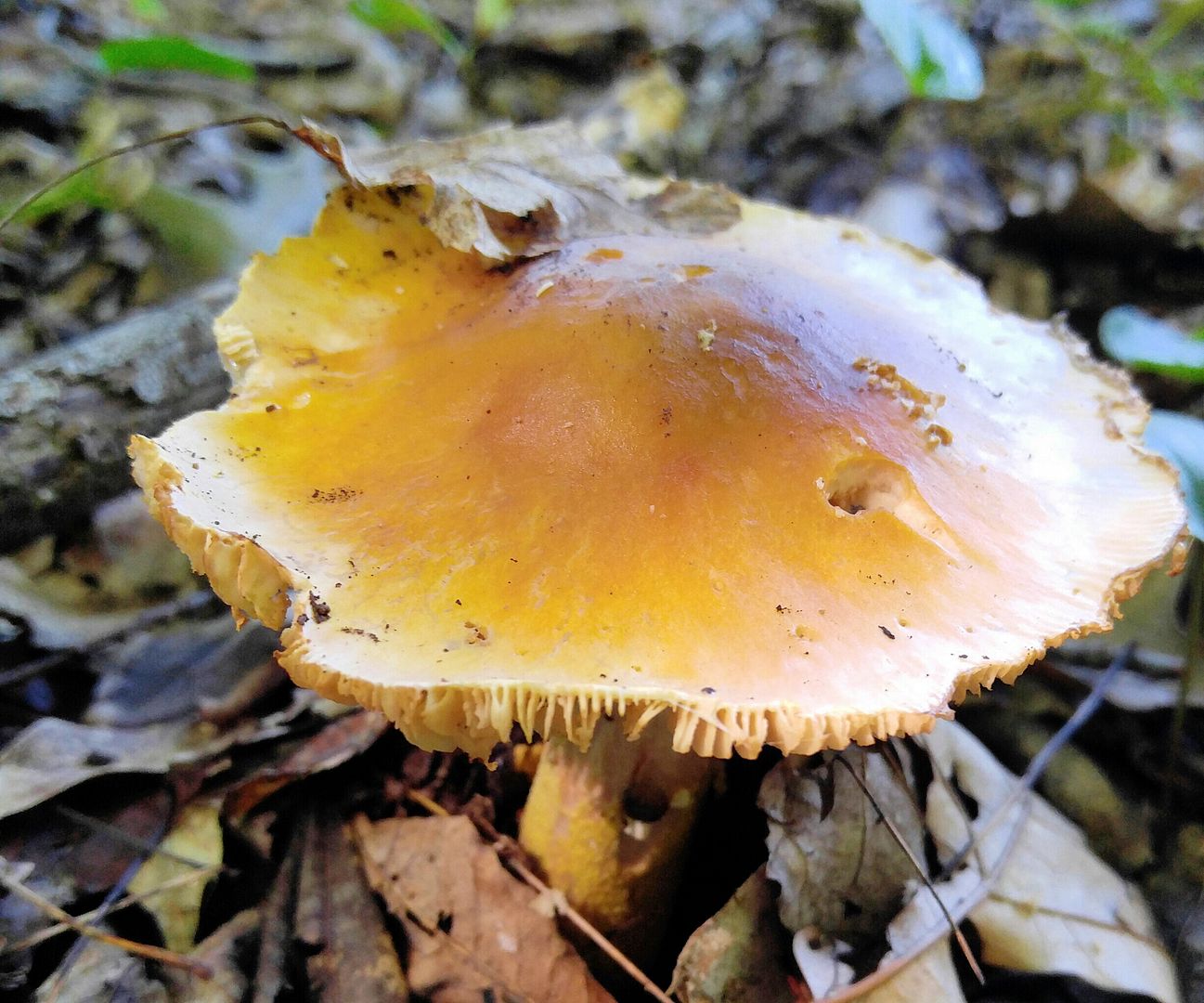
Not a baby. There are holes in the cap, the edges are torn and chewed, and the gills are ragged. Fortunately, by this point it has probably released lots of spores. And by lots, I mean LOTS... a good-sized mushroom like this can produce several BILLION spores. And a polypore growing on a tree can do this every single day from mid-spring to frost. This is a mind-numbing number of spores.
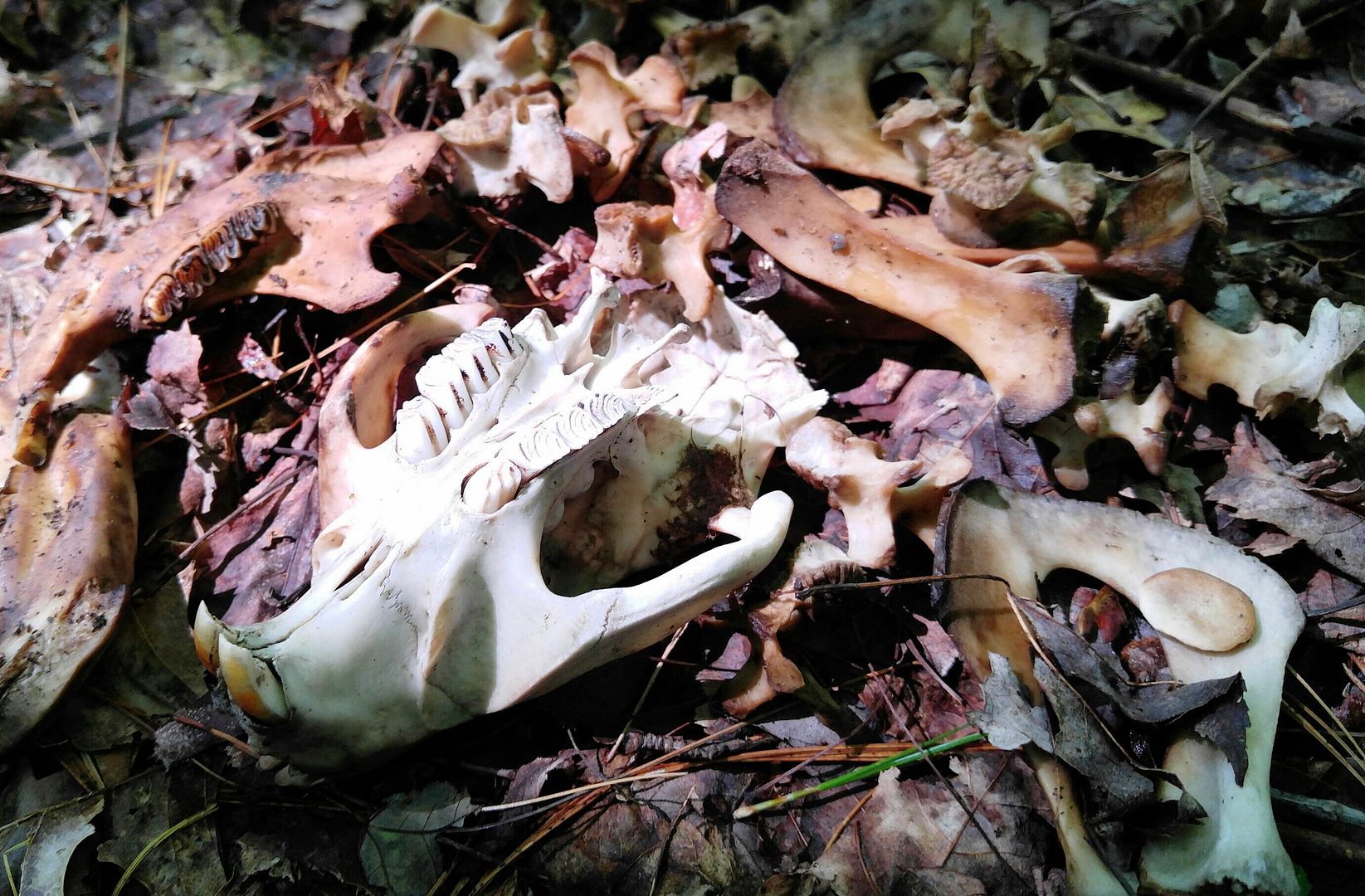
Found another skeleton! Definitely not a deer... I think it washed out from somewhere during the flooding and heavy rain we had recently. I believe it is a beaver, but beaver and groundhog skulls look very similar (so do muskrat skulls, but they are much smaller).
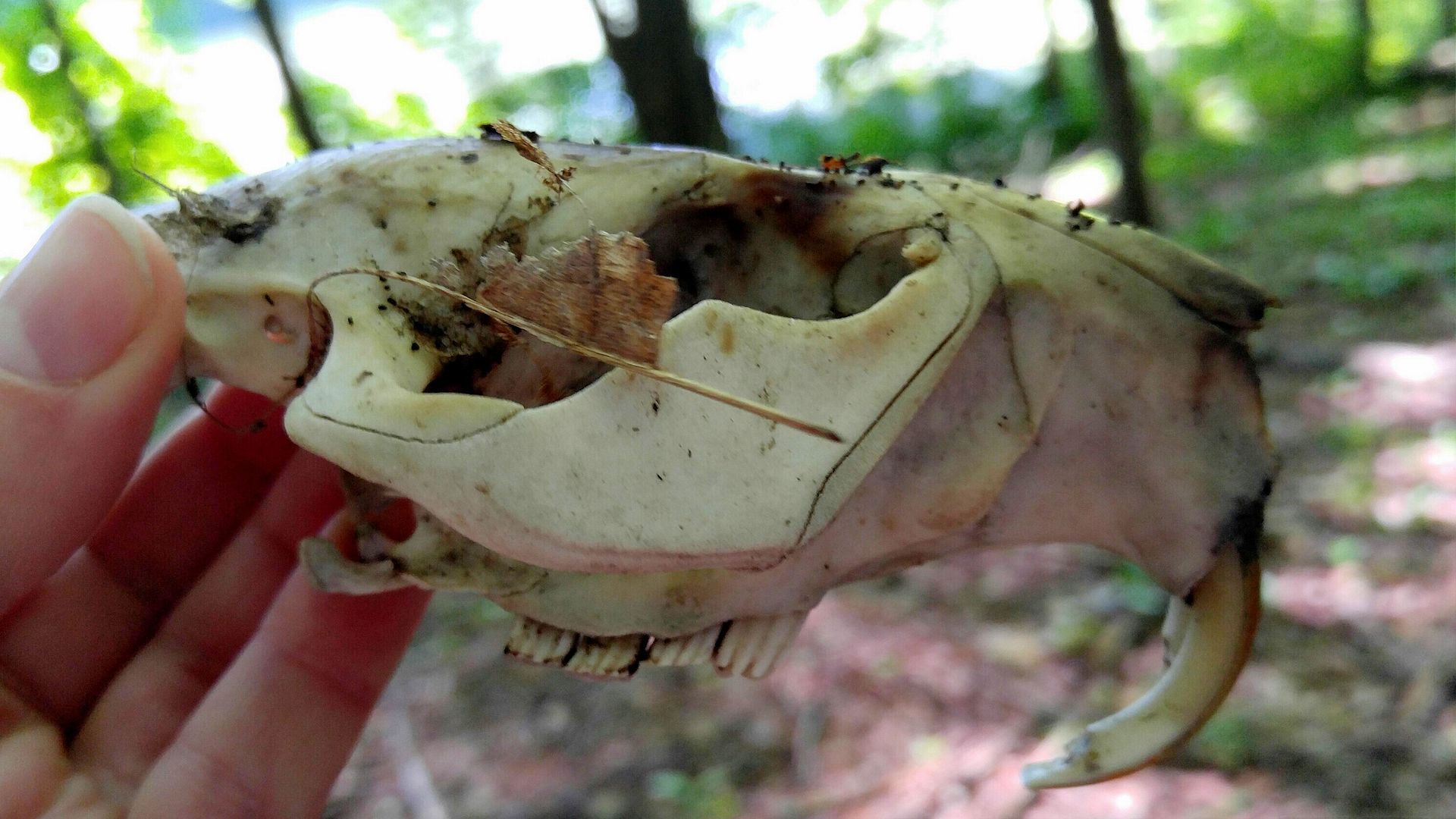
Unquestionably rodent teeth. The spectacular success of the rodents comes from those teeth... unlike almost any other animal, rodent teeth never stop growing. This is why they can chew through almost anything, eat almost anything, and therefore live almost anywhere.
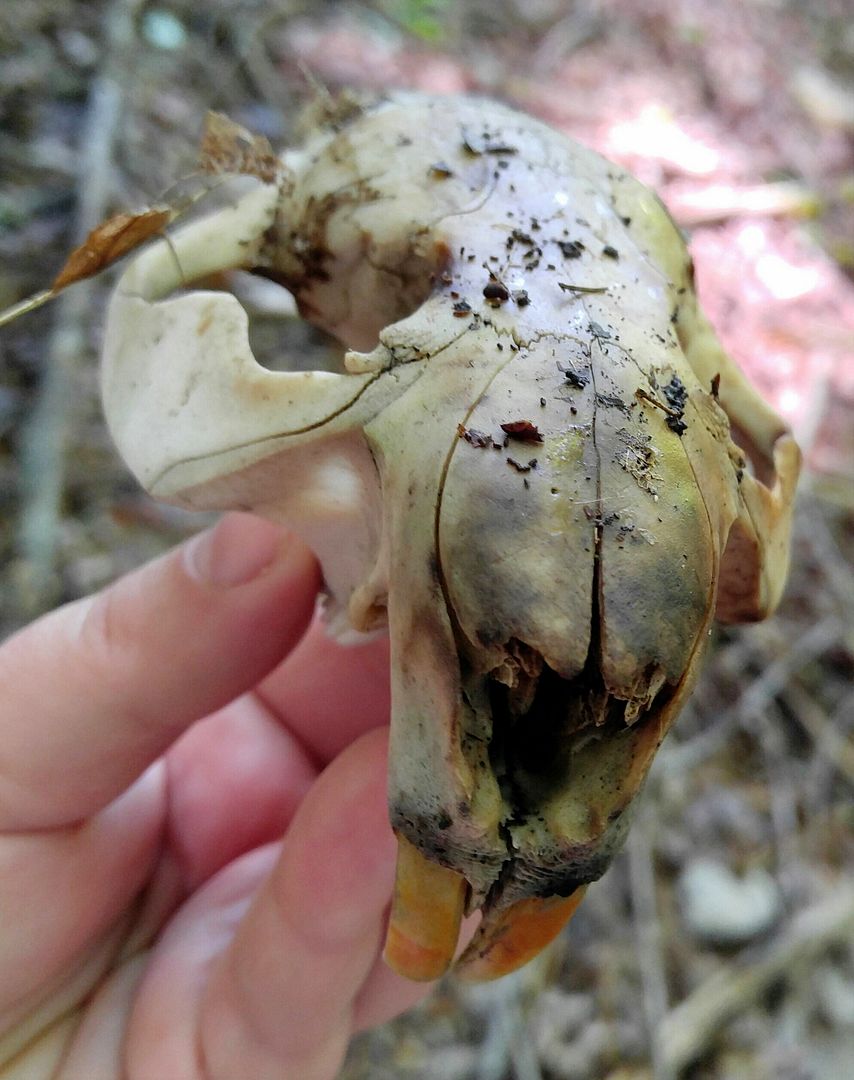
Skulls are marvelous. Because mammals are born alive and at least in placental mammals are usually fairly well-developed, their skulls have sutures just like a human baby's where the bones fused it grew.
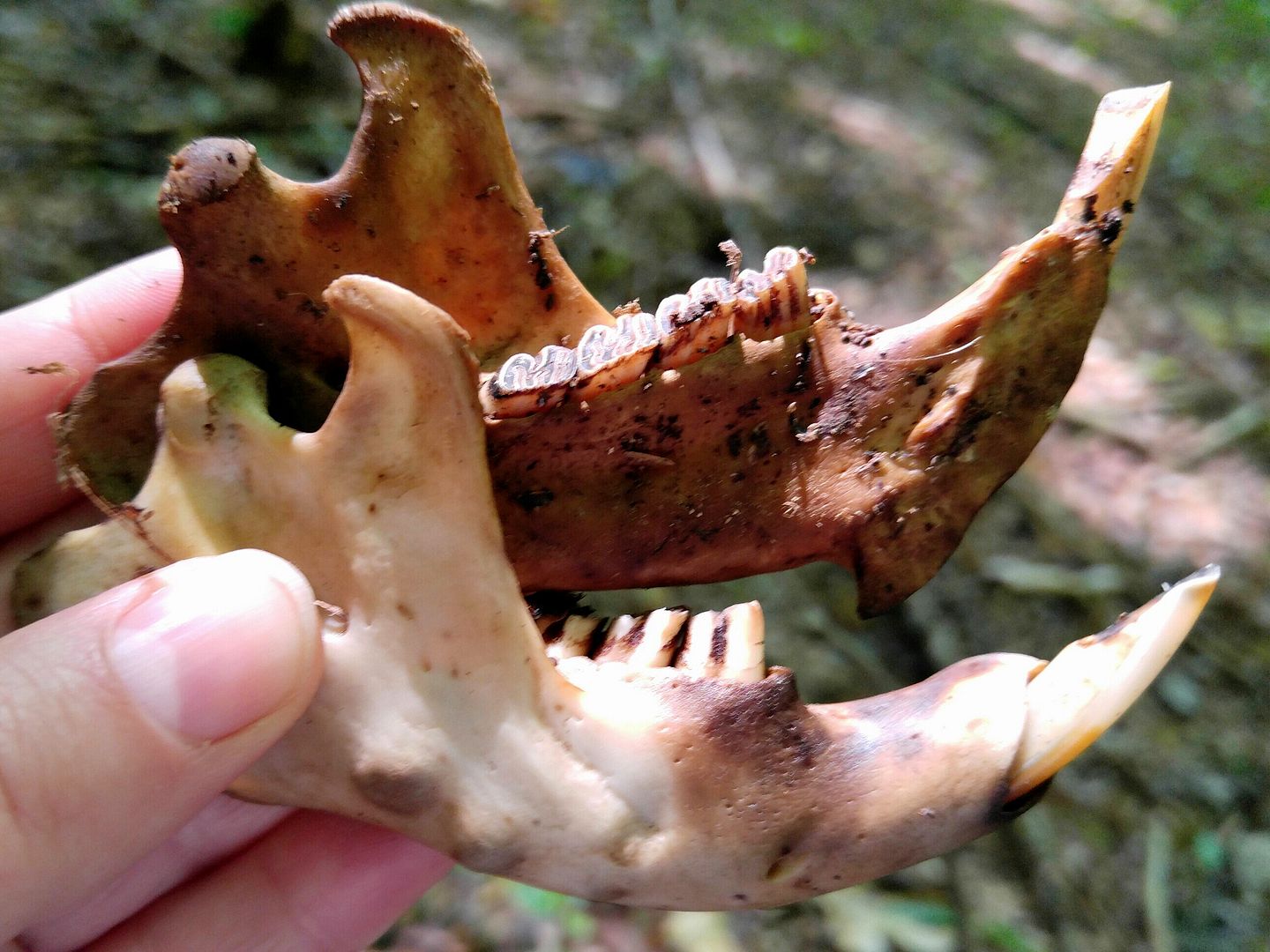
When I find a skull I am rarely lucky enough to find the lower jaws along with it, but these ones were available for my inspection. They still don't tell me exactly what it is... beaver and groundhog teeth are very similar and they are fairly close relatives.
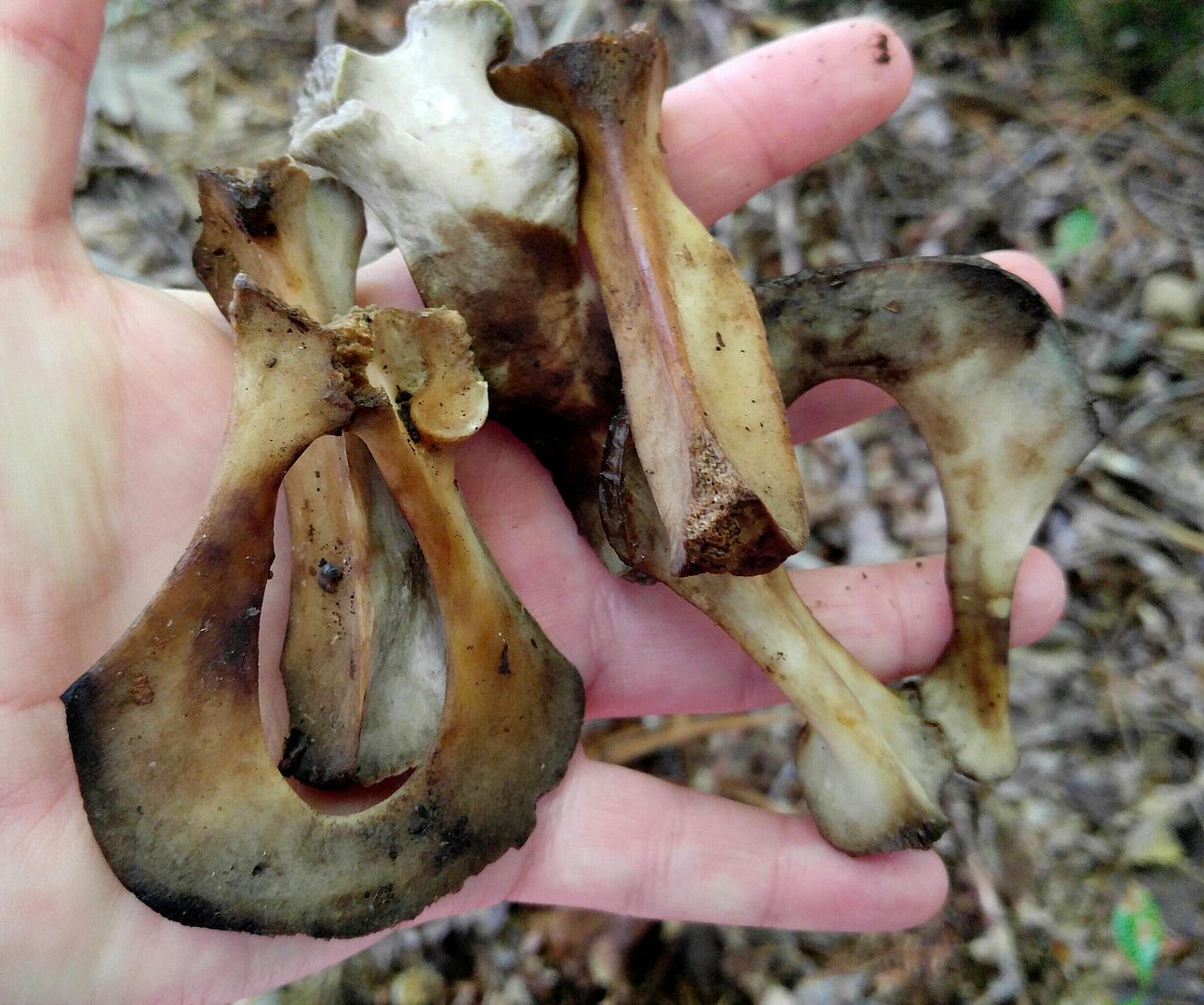
I found a handful of other assorted pieces, including some vertebrae, some femurs, and what is clearly a pelvis.
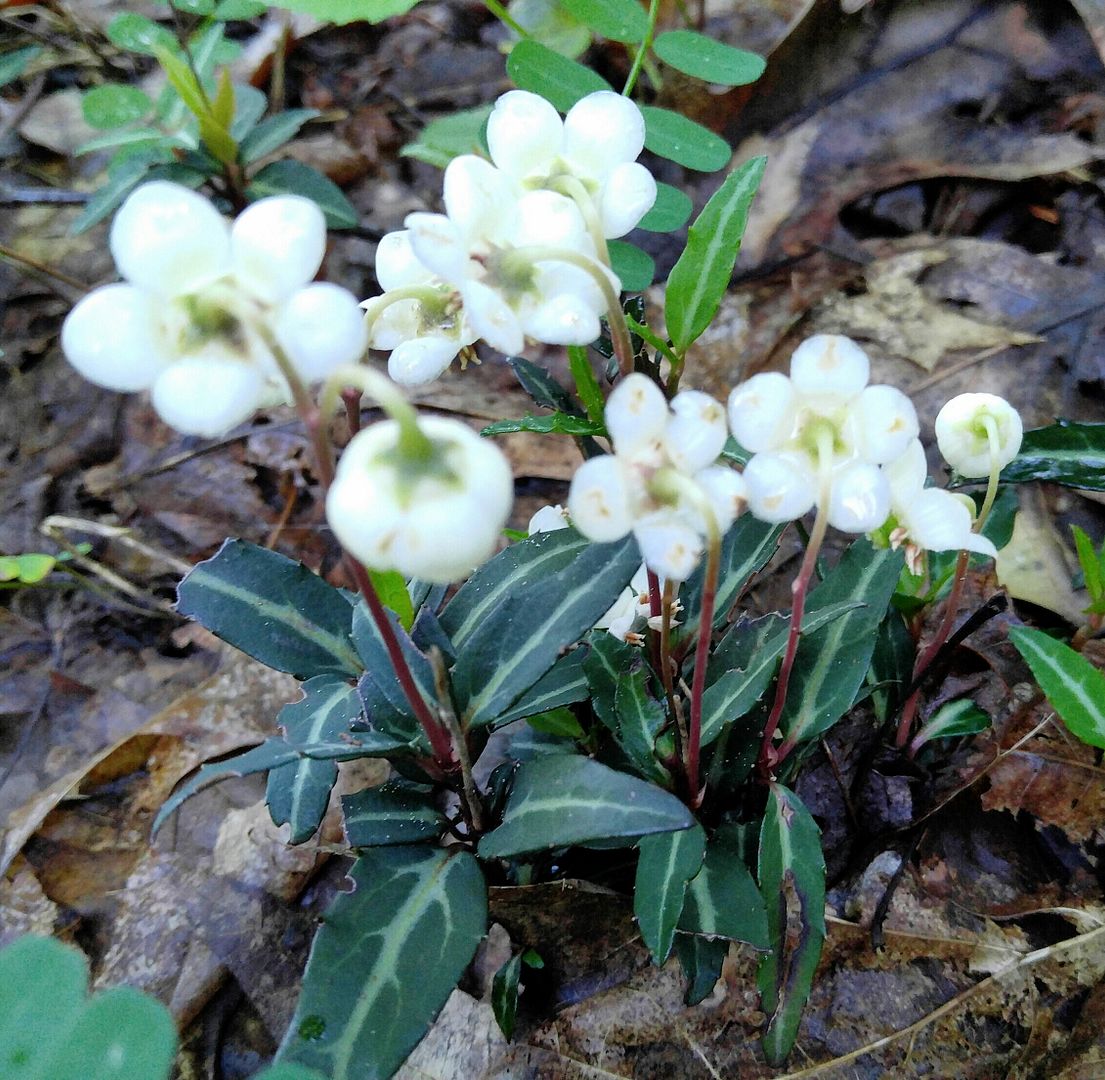
I know I've showed you these before, but I don't care. They are Chimaphila maculata, otherwise known as striped wintergreen. Despite the association of "wintergreen" and "minty", these are not related to the mint family... they actually belong to the heather family (and share with other family members a tolerance for poor, sandy, or very acidic soil, which is why these are tolerating growing under oak trees and ignoring the acidic tannins the leaves release).
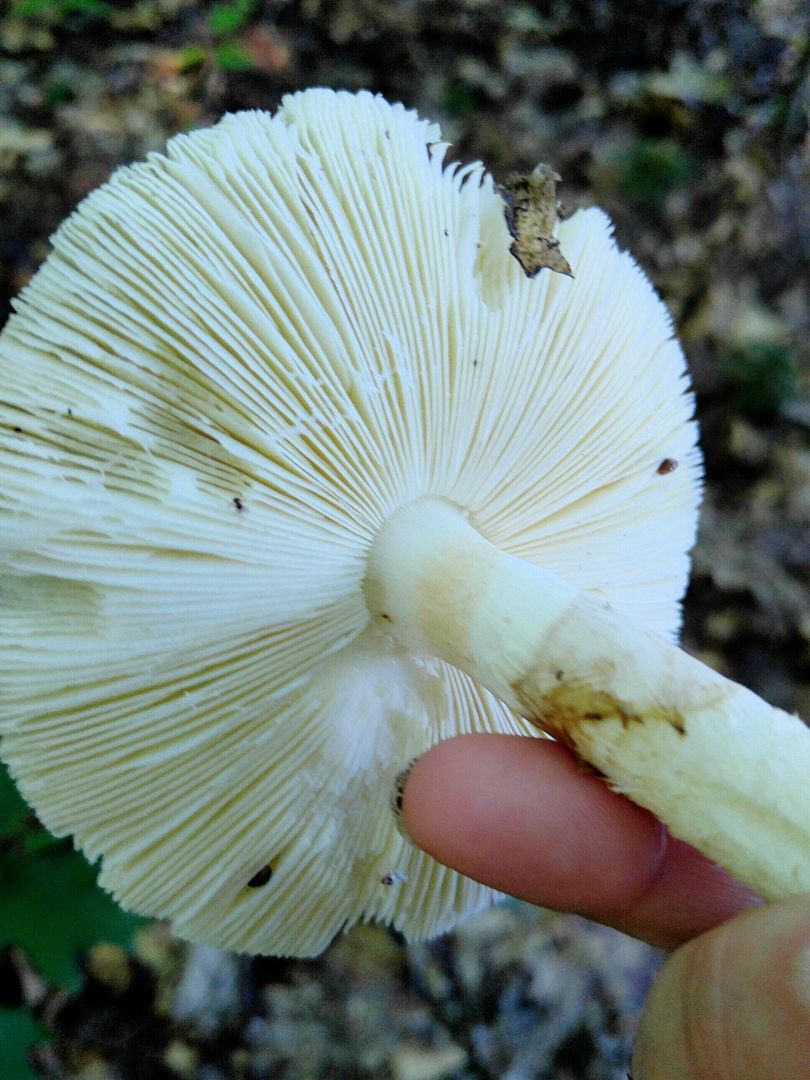
This one had been knocked over, probably by either a person or animal who wanted to see if it was edible. If it was a person, they probably left it because it is probably not edible... only the most experienced and/or daring mushroom hunters will eat mushrooms with white gills not attached to the stem and a veil (which has mostly decayed off this one) because these are warnings of amanitas, which can be deadly. Some of them are edible and some things look like amanitas and aren't, but most people are better off sticking to more easily identified things. There are some very common edible white mushrooms around here but they have pink-to-brown gills.
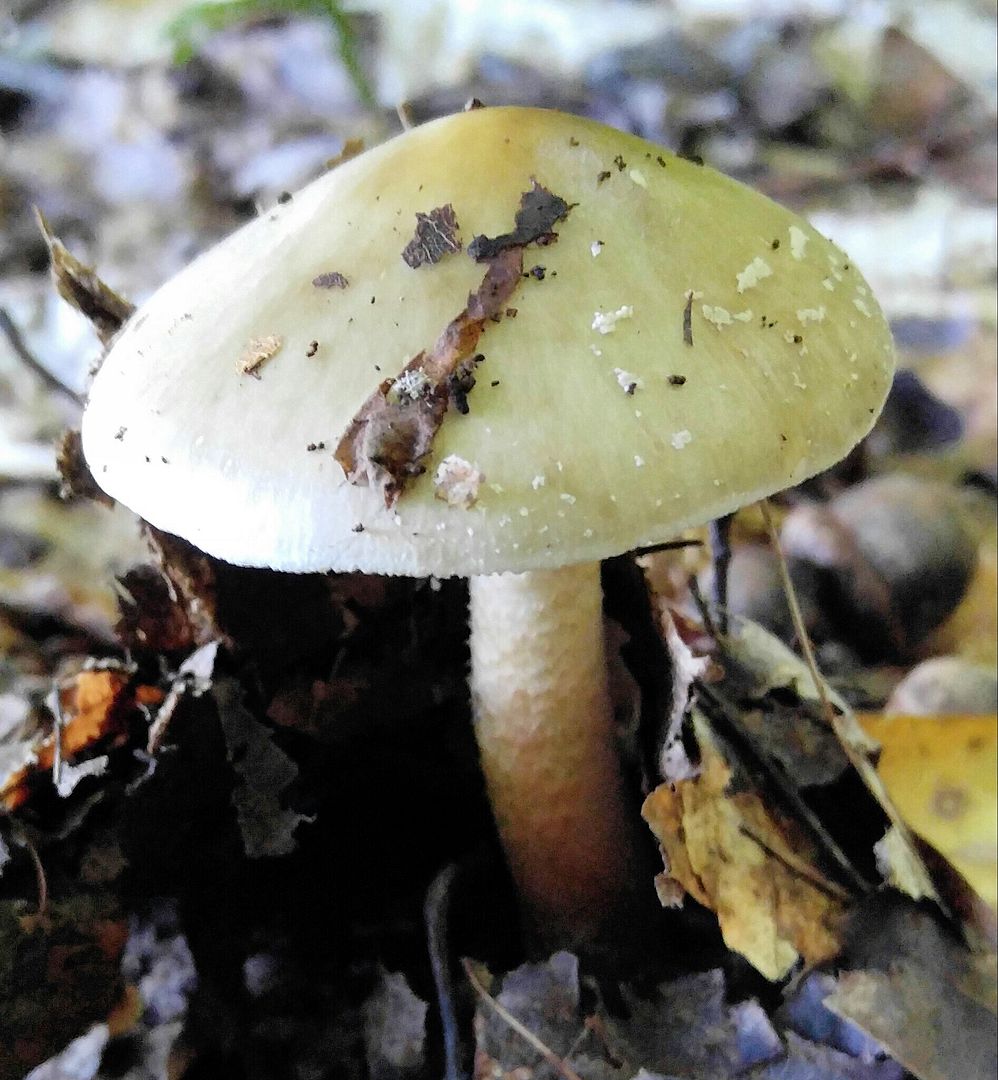
Recently emerged and still draped with leaves... I always wonder how many mushrooms I miss because they are JUST about to push through the leaves but haven't yet.
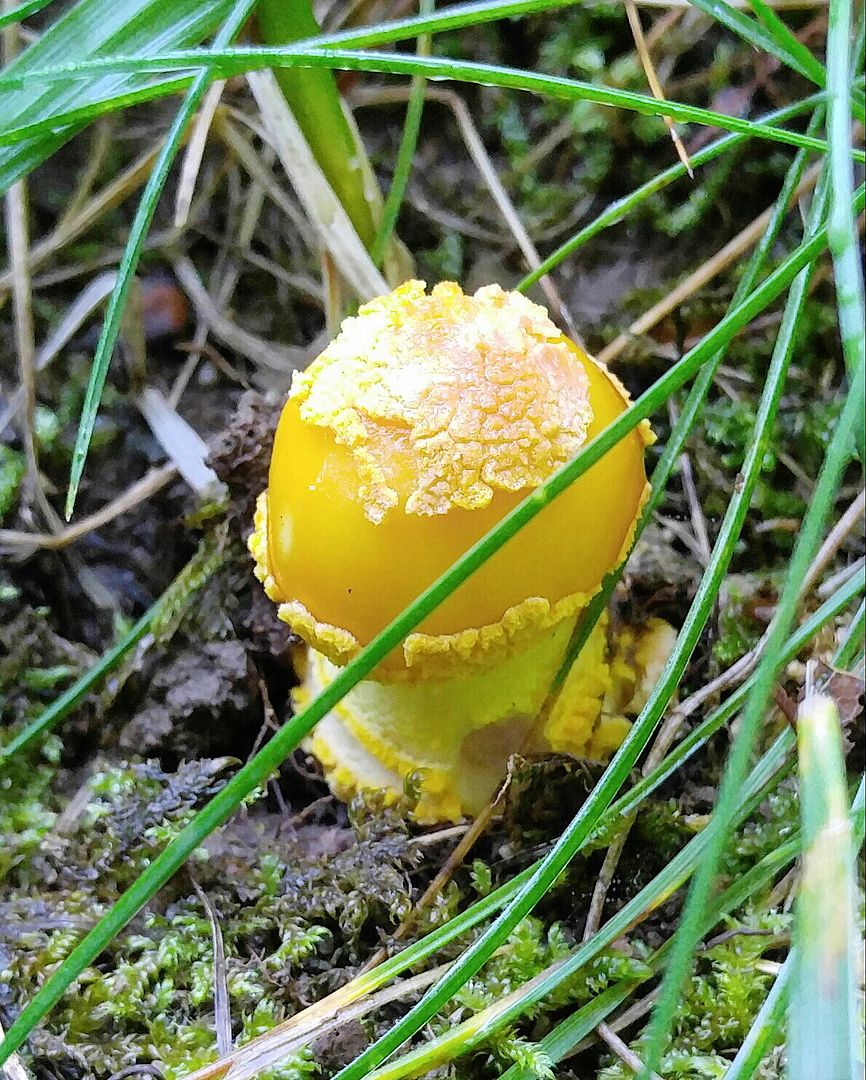
This perfect little baby is so brand new that it has just recently separated the cap from the protective veil (pieces of it are still attached to the cap and the stem).
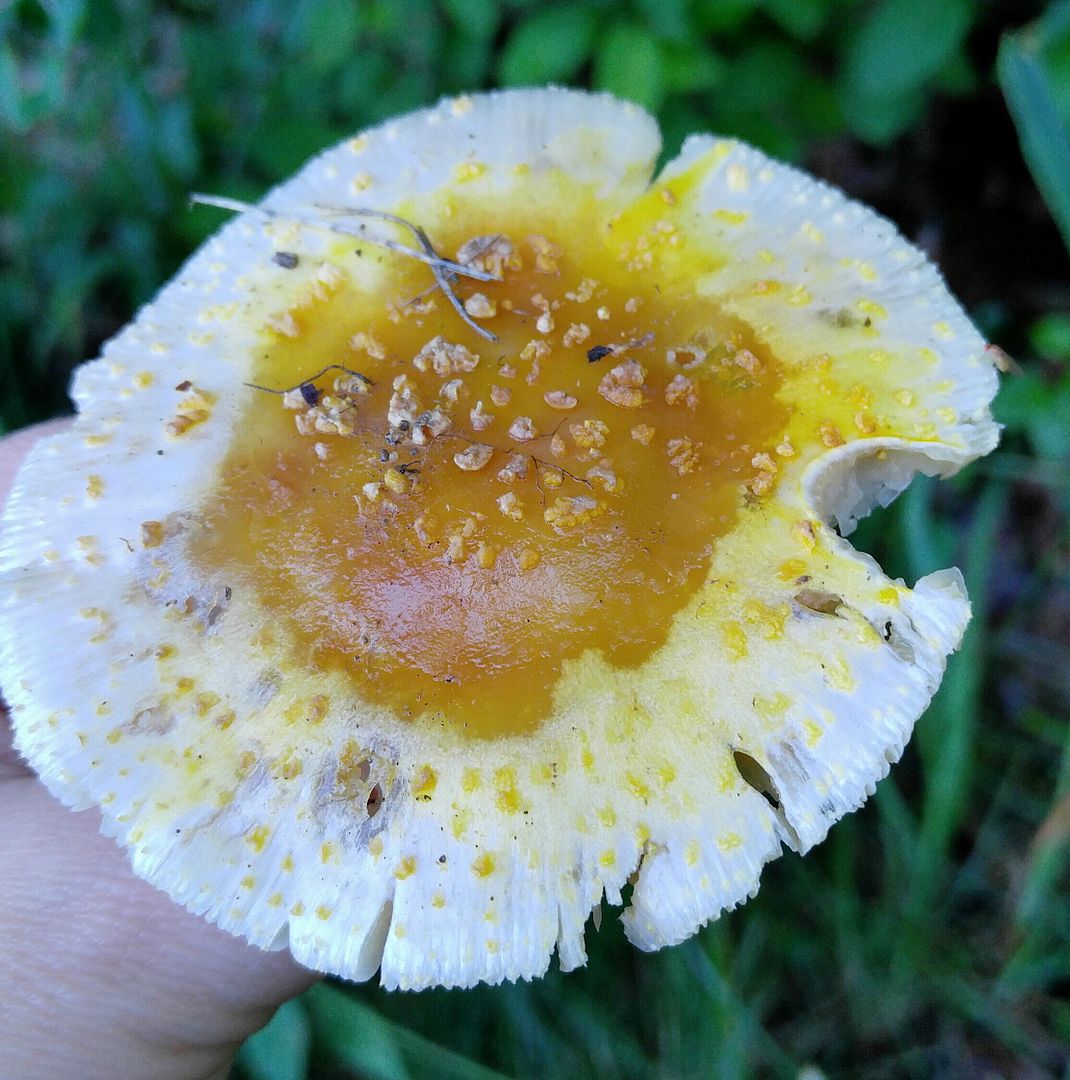
A much more mature specimen of the same thing. There are still bits of the original veil attached to the cap. The large bite out of the side is probably from slugs. Slugs love mushrooms and are therefore not loved by people who love mushrooms.

The bladderworts are all closed up in the bright sunshine... they will open on cloudy days or in the morning and evening.

The milkweeds are blooming. The flowers are lovely, but after discovering the milkweed bugs living in their pods last fall, I'm more excited for those...

Possibly turkey tails, but there are false turkey tails too, so I'm not placing any bets.
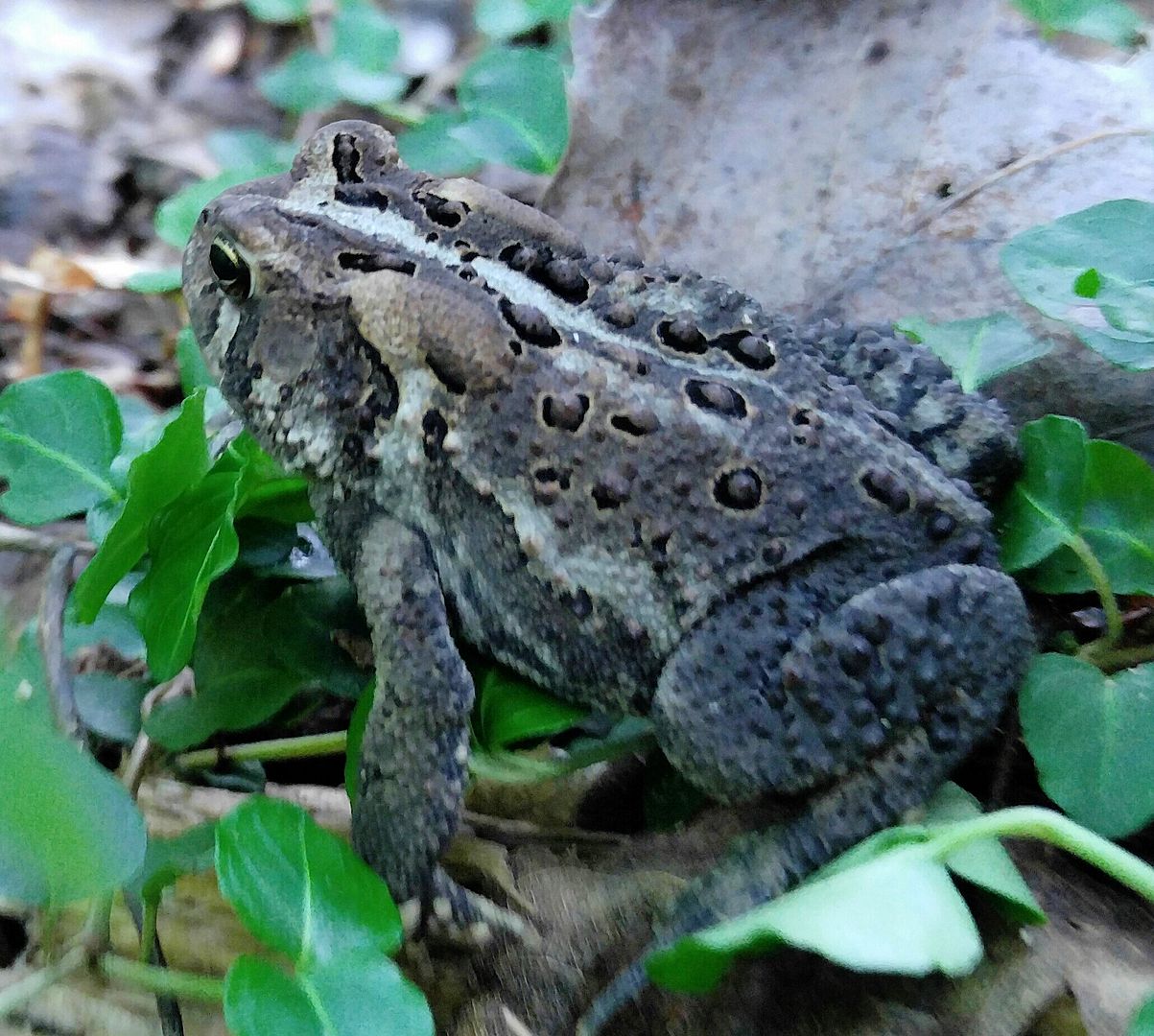
Not a mushroom. He did scare the shit out of me while I was looking for mushrooms with my nose near the ground.
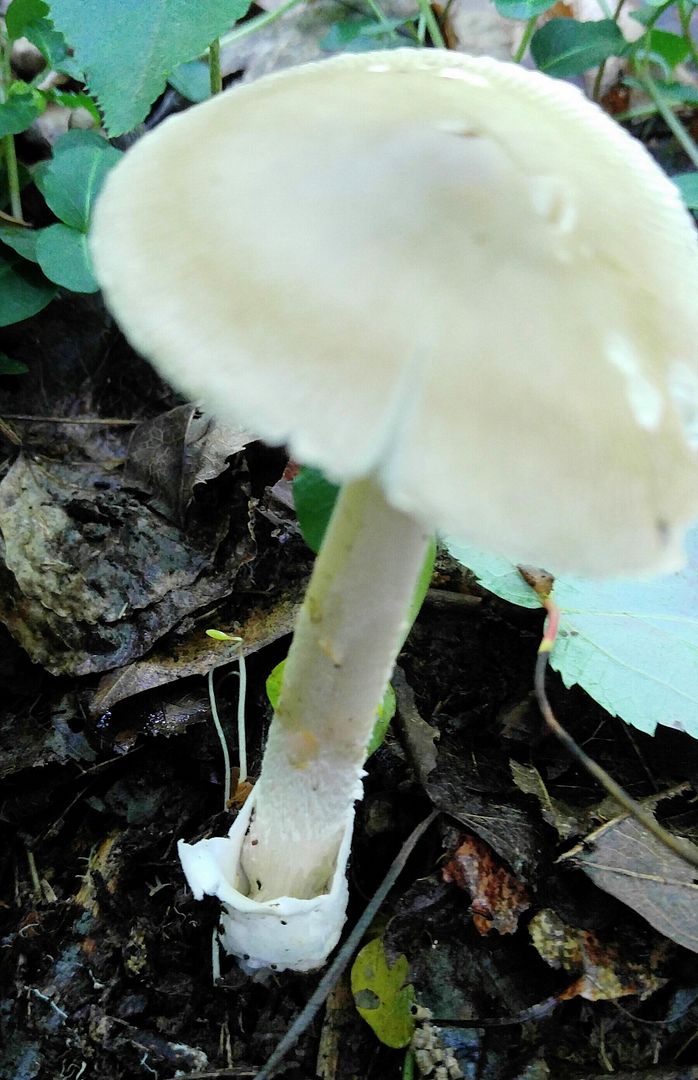
I dug around the base a little but to show you why if you eat mushrooms you must always DIG, not PICK... this bit around the base is called the volva. It is part of the veil that covered the whole mushroom as a baby, and it is one warning that a mushroom might be something poisonous (not all mushrooms with a volva are poisonous, but amanitas are, and this is a warning sign).
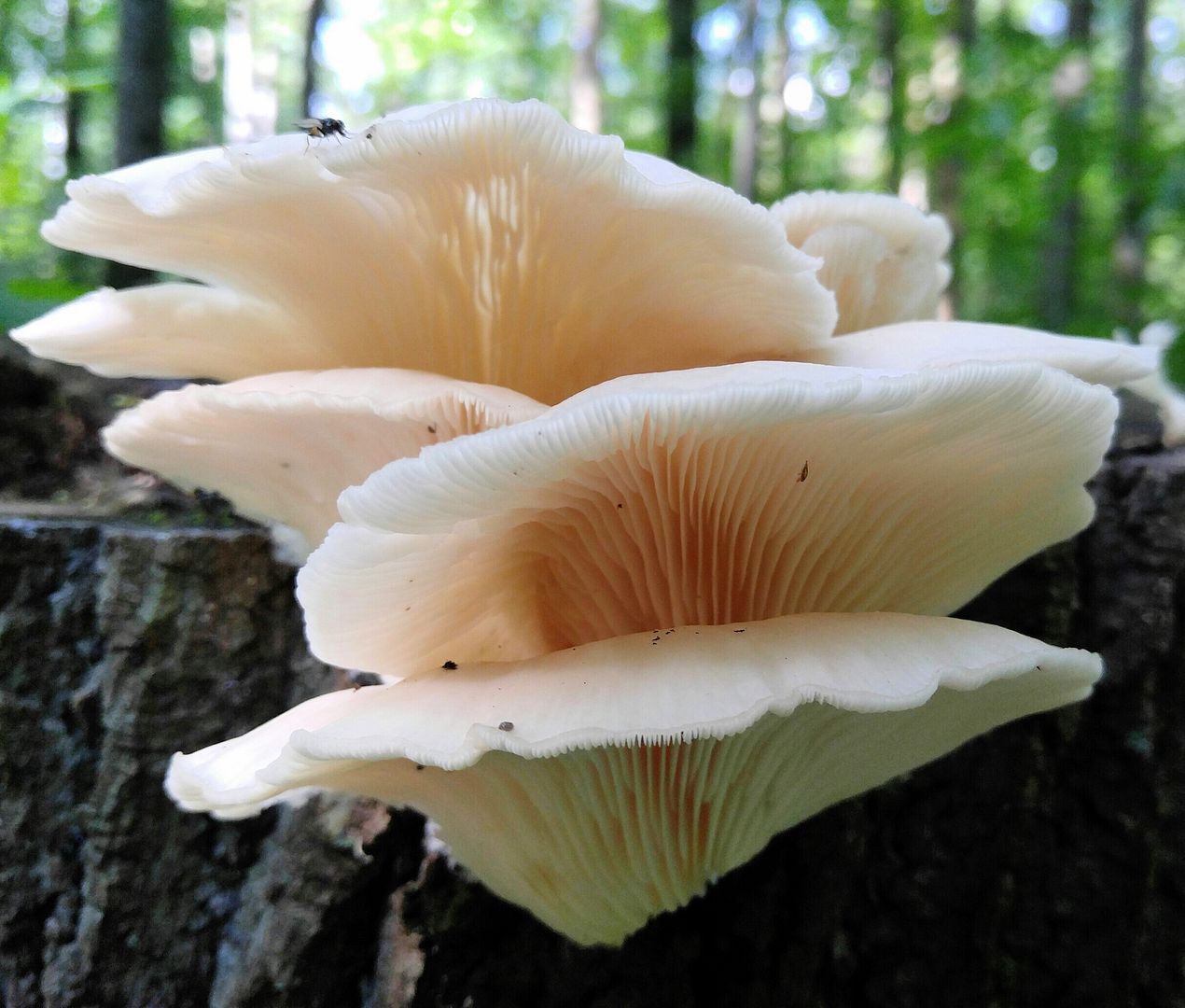
These are definitely edible oyster mushrooms... but the one condition is that you get to them before the slugs, insects, and larvae do. Oysters grow in tight clumps and that means they are a great habitat for all kinds of things that you do not want with your mushrooms.
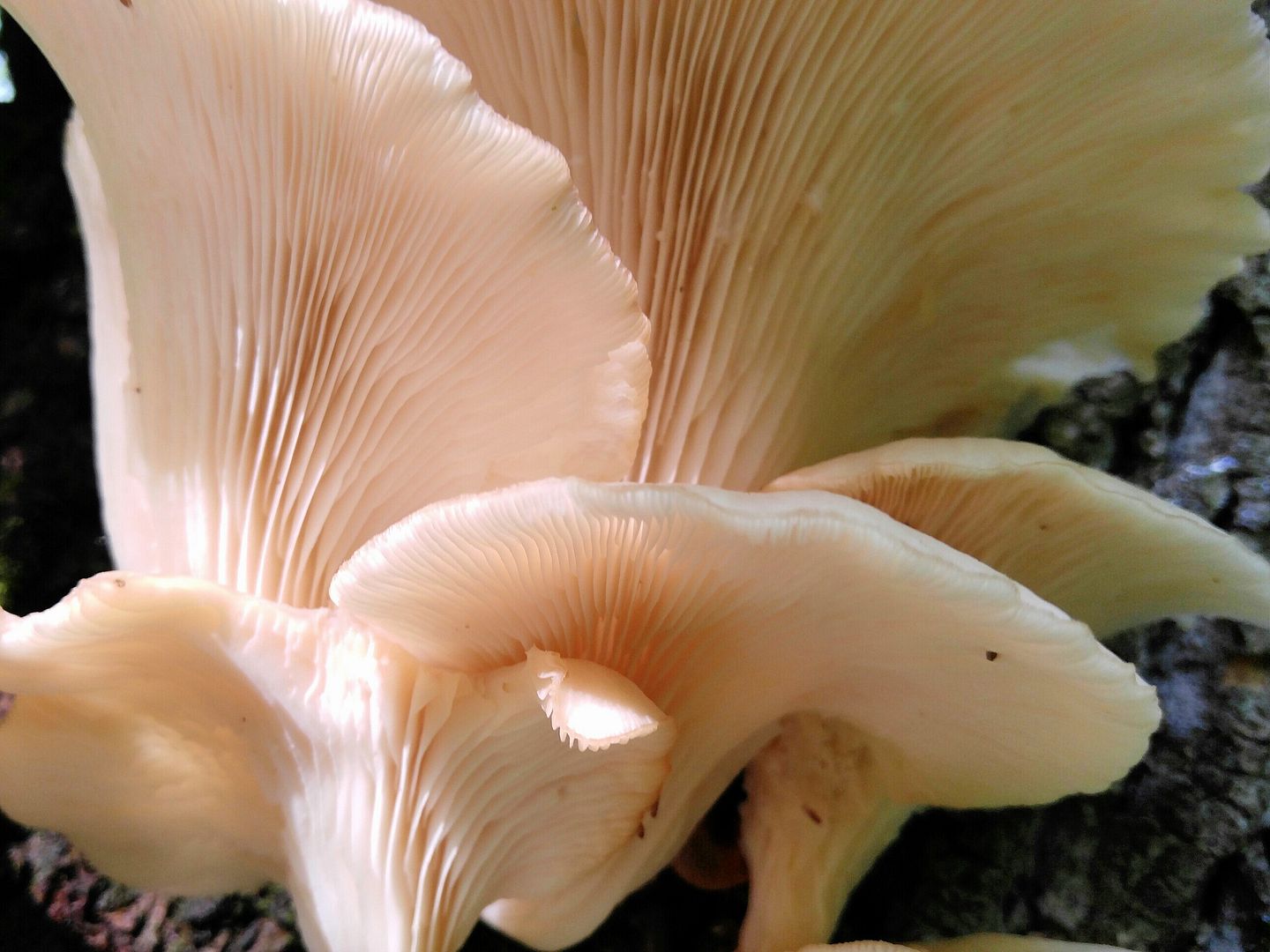
Some people would still pick and eat these but I don't do much in the way of wild mushroom harvesting, and while these are gorgeous they are also a bit past the best eating stage.
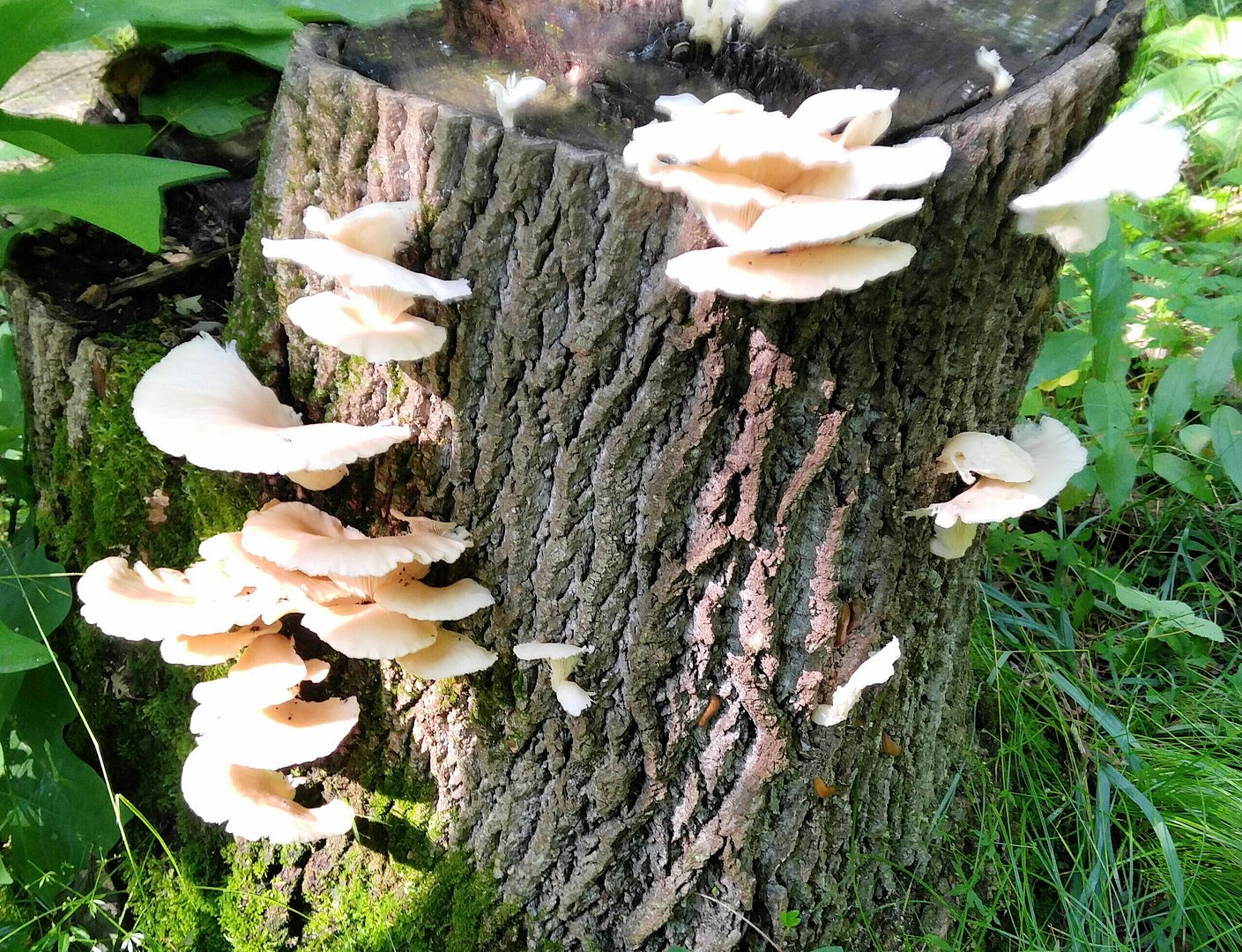
I will, however, keep this stump on my radar... next year I will be keeping an eye on it and getting to these oysters before the bugs do.
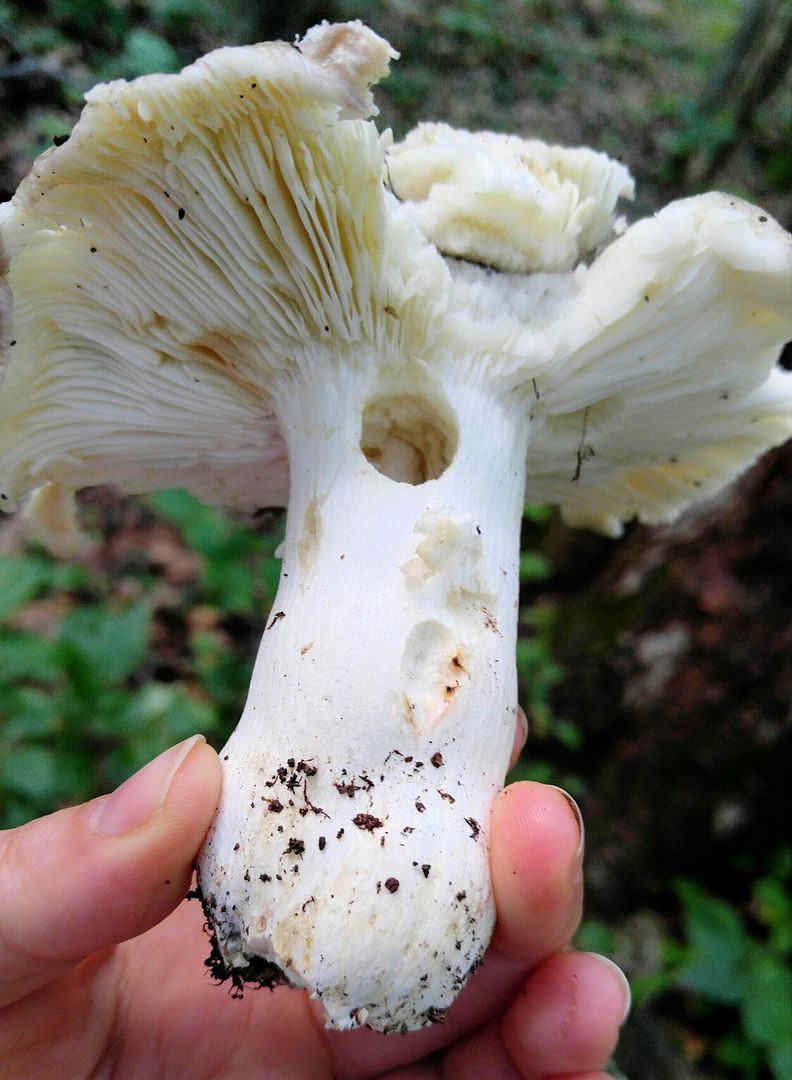
Found this one knocked over... might or might not have had a volva, but with the attached gills it is probably not an amanita. It never fails to puzzle me exactly why insects and things that eat mushrooms choose to just chew random holes right through them and then leave... this one also looks like a deer or some other animal took a bite out of it. Perhaps they didn't appreciate the extra protein content in the form of a healthy maggot population.
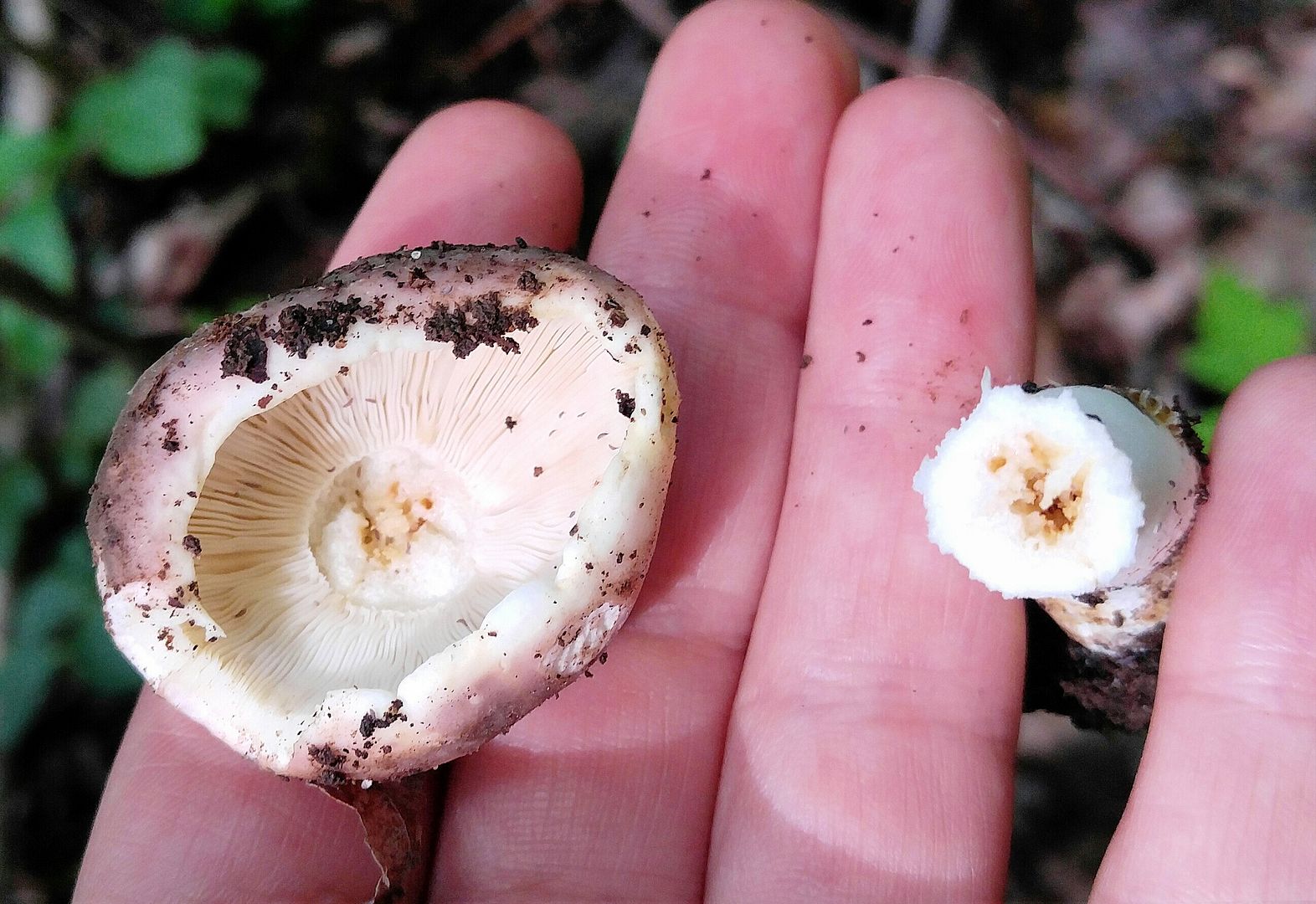
Cool little example of un-attached gills... the one in the last picture, you can see how the stem and cap would not separate cleanly like this because the gills are attached to the stem. This little one is probably some sort of Russula, only because it seems like everything is a Russula until proven otherwise.
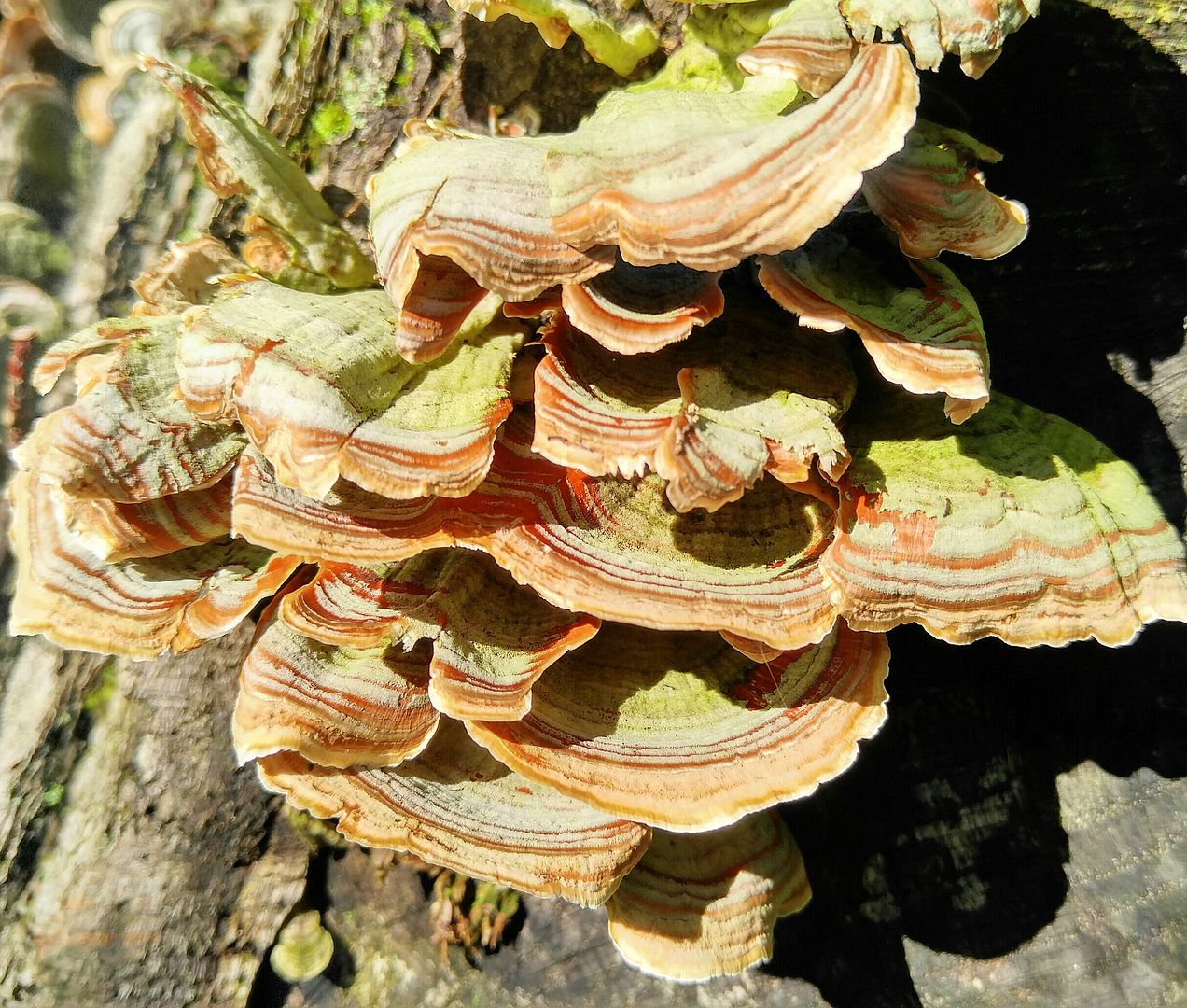
These are not Russula, but I don't think they are turkey tails either, although they might be, because people will call anything that looks like this a turkey tail regardless of whether that's what it is.
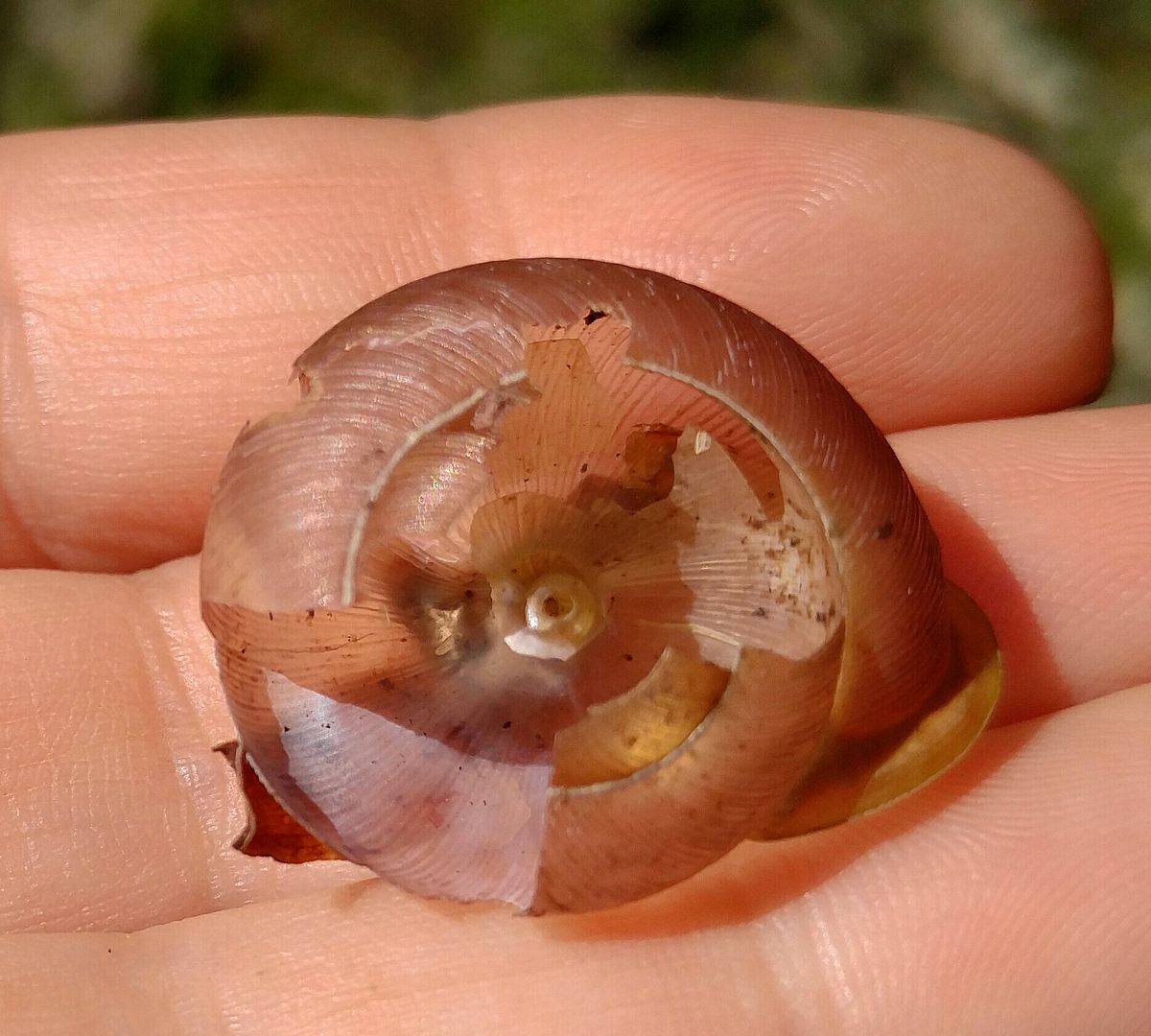
Not a mushroom, but just as cool... I don't know what happened to the inhabitant, but this incredibly delicate thing is an amazing find.

Every ridge, like rings on a tree, is another layer of growth the snail added to its shell as it got bigger.
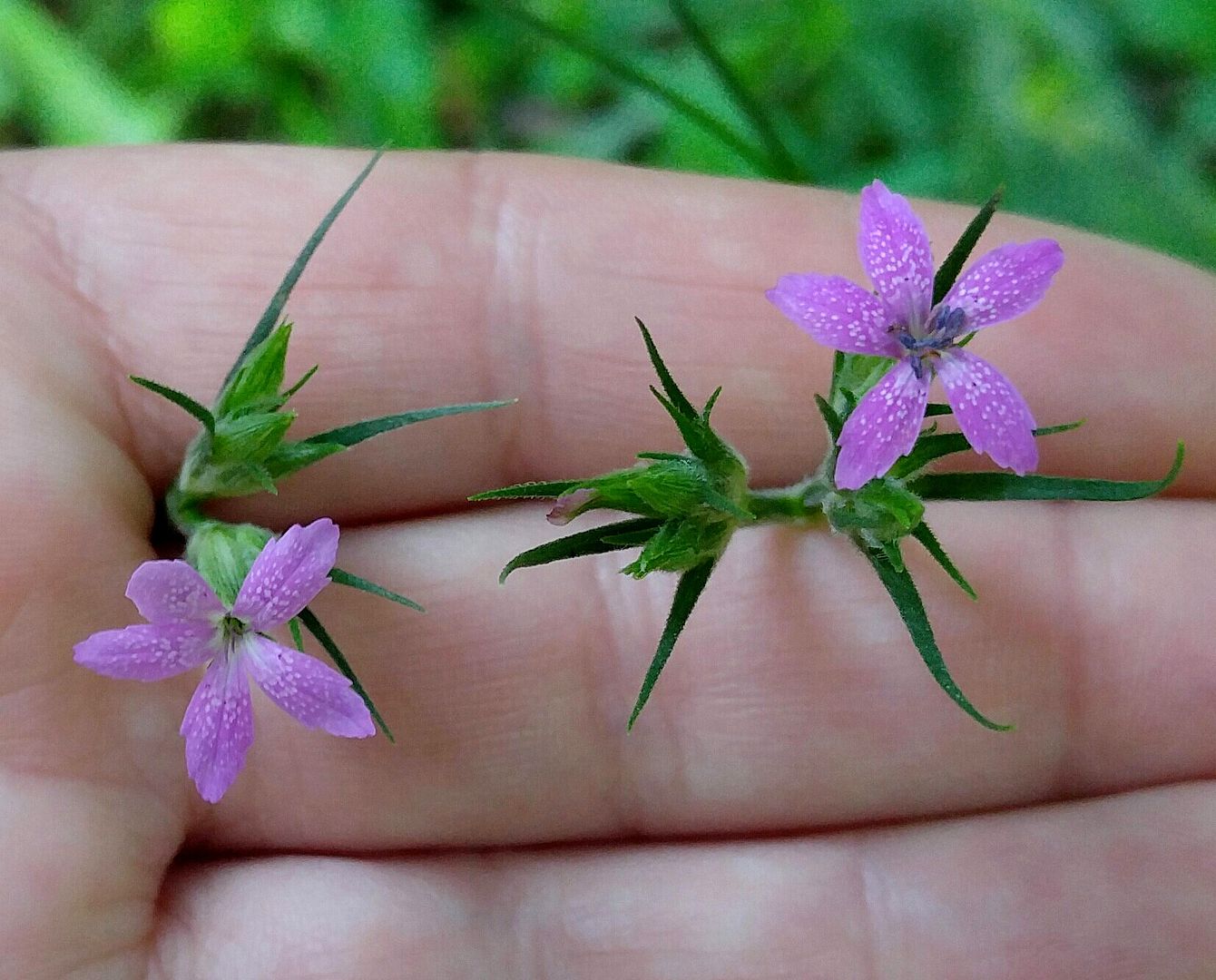
Just to prove I do look at things other than mushrooms sometimes, these little beauties are Dianthus armeria, also known as Deptford Pink (I have no idea what the hell that name is supposed to mean and they're not even really pink). They are naturalized but not native to North America... they belong to Europe, where they are apparently common. They tolerate very poor soil and wet places. Dianthus are members of the very large and widespread carnation family Caryphyllaceae.
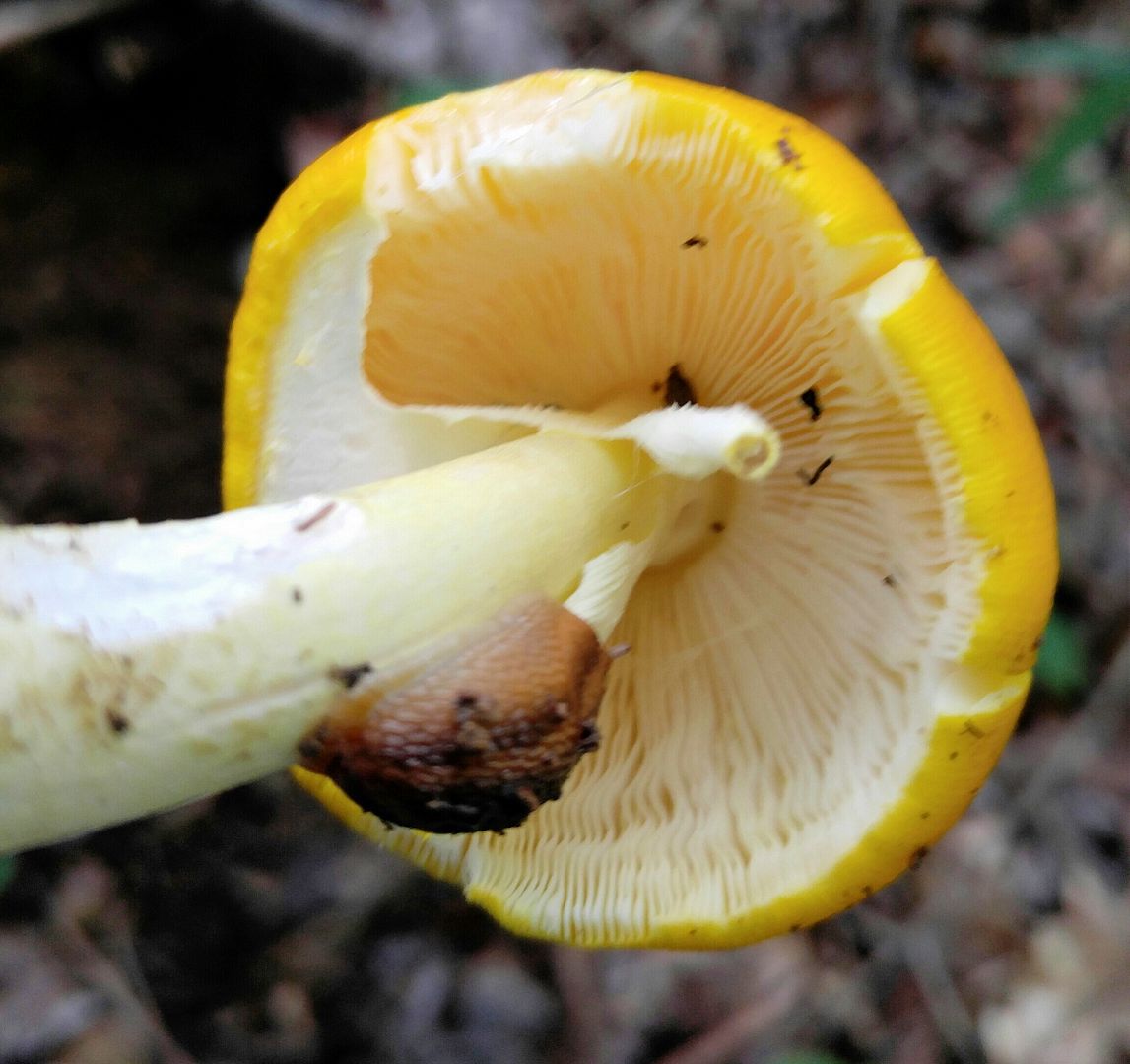
Here's a young mushroom that has three things... un-attached gills, a bit of the veil still clinging to the underside of the cap (it would tear off and cling to the stem as the cap opened) and a stupid slug already munching on it.
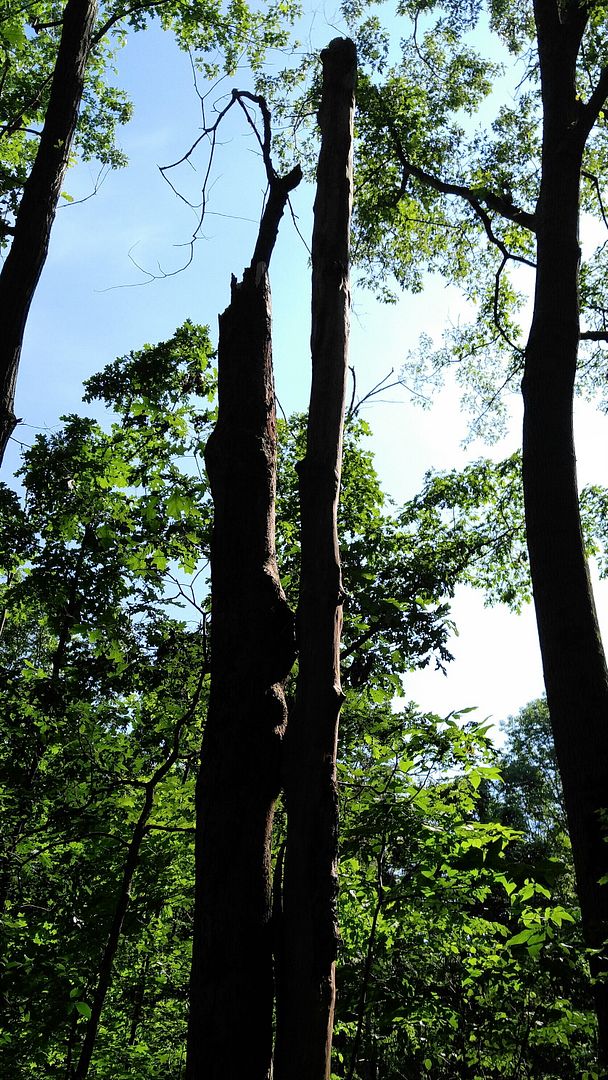
And for those of you who have followed the saga of the Kissing Trees for years of nature posts, the one on the right died and has taken its partner with it (in reality that is a lie and they are actually the same tree whose trunks split at the base). They are now both quite dead... but I could have guessed that from the MASSIVE number of honey mushrooms that came up at the base last fall (honey mushrooms are parasites on living tree roots and will happily continue to eat them after they are dead; it spreads between trees and can infect many, many trees, becoming some of the largest organisms on the planet and covering miles of forest).
And that will be all.
.
.
.
Anyway...

This was not a promising start to my mushroom search.

This is bee balm, one of the prettiest and most brightly colored wildflowers. They are native to North America and are members of the mint family.

Found this pretty little one... and I cleared some of the leaves away at the base. If you look, the white fuzzy stuff is the actual fungus. The mushroom is just a fruiting body, temporary and meant only for spore dispersal. It's as if all we ever saw of a tree was when the fruit popped out of the ground, and we never thought about the entire tree living underneath. This one mushroom has a large mass of mycelium under it, digesting many layers of dead leaves and turning them into soil.

Turtle shells! They've been there since last time I showed them to you, but I didn't give you an idea of size or a close-up view then. You can tell just to look at them that these are not bird eggs... reptile eggs will crush if you squeeze them, but the texture is much more leathery and flexible than a bird egg. It's thought that the first feathers probably did not evolve for flight... after all, several sorts of things were already flying quite well without any such thing... but as insulation for nesting dinosaurs who sat on their nests like big, toothy chickens.

You can tell a mushroom is a baby if nothing has eaten holes in it yet.

Not a baby. There are holes in the cap, the edges are torn and chewed, and the gills are ragged. Fortunately, by this point it has probably released lots of spores. And by lots, I mean LOTS... a good-sized mushroom like this can produce several BILLION spores. And a polypore growing on a tree can do this every single day from mid-spring to frost. This is a mind-numbing number of spores.

Found another skeleton! Definitely not a deer... I think it washed out from somewhere during the flooding and heavy rain we had recently. I believe it is a beaver, but beaver and groundhog skulls look very similar (so do muskrat skulls, but they are much smaller).

Unquestionably rodent teeth. The spectacular success of the rodents comes from those teeth... unlike almost any other animal, rodent teeth never stop growing. This is why they can chew through almost anything, eat almost anything, and therefore live almost anywhere.

Skulls are marvelous. Because mammals are born alive and at least in placental mammals are usually fairly well-developed, their skulls have sutures just like a human baby's where the bones fused it grew.

When I find a skull I am rarely lucky enough to find the lower jaws along with it, but these ones were available for my inspection. They still don't tell me exactly what it is... beaver and groundhog teeth are very similar and they are fairly close relatives.

I found a handful of other assorted pieces, including some vertebrae, some femurs, and what is clearly a pelvis.

I know I've showed you these before, but I don't care. They are Chimaphila maculata, otherwise known as striped wintergreen. Despite the association of "wintergreen" and "minty", these are not related to the mint family... they actually belong to the heather family (and share with other family members a tolerance for poor, sandy, or very acidic soil, which is why these are tolerating growing under oak trees and ignoring the acidic tannins the leaves release).

This one had been knocked over, probably by either a person or animal who wanted to see if it was edible. If it was a person, they probably left it because it is probably not edible... only the most experienced and/or daring mushroom hunters will eat mushrooms with white gills not attached to the stem and a veil (which has mostly decayed off this one) because these are warnings of amanitas, which can be deadly. Some of them are edible and some things look like amanitas and aren't, but most people are better off sticking to more easily identified things. There are some very common edible white mushrooms around here but they have pink-to-brown gills.

Recently emerged and still draped with leaves... I always wonder how many mushrooms I miss because they are JUST about to push through the leaves but haven't yet.

This perfect little baby is so brand new that it has just recently separated the cap from the protective veil (pieces of it are still attached to the cap and the stem).

A much more mature specimen of the same thing. There are still bits of the original veil attached to the cap. The large bite out of the side is probably from slugs. Slugs love mushrooms and are therefore not loved by people who love mushrooms.

The bladderworts are all closed up in the bright sunshine... they will open on cloudy days or in the morning and evening.

The milkweeds are blooming. The flowers are lovely, but after discovering the milkweed bugs living in their pods last fall, I'm more excited for those...

Possibly turkey tails, but there are false turkey tails too, so I'm not placing any bets.

Not a mushroom. He did scare the shit out of me while I was looking for mushrooms with my nose near the ground.

I dug around the base a little but to show you why if you eat mushrooms you must always DIG, not PICK... this bit around the base is called the volva. It is part of the veil that covered the whole mushroom as a baby, and it is one warning that a mushroom might be something poisonous (not all mushrooms with a volva are poisonous, but amanitas are, and this is a warning sign).

These are definitely edible oyster mushrooms... but the one condition is that you get to them before the slugs, insects, and larvae do. Oysters grow in tight clumps and that means they are a great habitat for all kinds of things that you do not want with your mushrooms.

Some people would still pick and eat these but I don't do much in the way of wild mushroom harvesting, and while these are gorgeous they are also a bit past the best eating stage.

I will, however, keep this stump on my radar... next year I will be keeping an eye on it and getting to these oysters before the bugs do.

Found this one knocked over... might or might not have had a volva, but with the attached gills it is probably not an amanita. It never fails to puzzle me exactly why insects and things that eat mushrooms choose to just chew random holes right through them and then leave... this one also looks like a deer or some other animal took a bite out of it. Perhaps they didn't appreciate the extra protein content in the form of a healthy maggot population.

Cool little example of un-attached gills... the one in the last picture, you can see how the stem and cap would not separate cleanly like this because the gills are attached to the stem. This little one is probably some sort of Russula, only because it seems like everything is a Russula until proven otherwise.

These are not Russula, but I don't think they are turkey tails either, although they might be, because people will call anything that looks like this a turkey tail regardless of whether that's what it is.

Not a mushroom, but just as cool... I don't know what happened to the inhabitant, but this incredibly delicate thing is an amazing find.

Every ridge, like rings on a tree, is another layer of growth the snail added to its shell as it got bigger.

Just to prove I do look at things other than mushrooms sometimes, these little beauties are Dianthus armeria, also known as Deptford Pink (I have no idea what the hell that name is supposed to mean and they're not even really pink). They are naturalized but not native to North America... they belong to Europe, where they are apparently common. They tolerate very poor soil and wet places. Dianthus are members of the very large and widespread carnation family Caryphyllaceae.

Here's a young mushroom that has three things... un-attached gills, a bit of the veil still clinging to the underside of the cap (it would tear off and cling to the stem as the cap opened) and a stupid slug already munching on it.

And for those of you who have followed the saga of the Kissing Trees for years of nature posts, the one on the right died and has taken its partner with it (in reality that is a lie and they are actually the same tree whose trunks split at the base). They are now both quite dead... but I could have guessed that from the MASSIVE number of honey mushrooms that came up at the base last fall (honey mushrooms are parasites on living tree roots and will happily continue to eat them after they are dead; it spreads between trees and can infect many, many trees, becoming some of the largest organisms on the planet and covering miles of forest).
And that will be all.
.
.
.